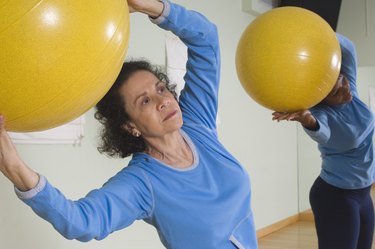
Weight loss at any age can improve your sense of well-being, your body's functions and overall health. The Centers for Disease Control and Prevention notes that losing just 5 to 10 percent of your body weight -- about 10 to 20 pounds for a 200-pound person -- can improve your blood pressure, blood cholesterol and blood sugar levels. As a 60-year-old person assigned female at birth (AFAB), weight loss may come more gradually than it did in your youth, but the positive effects are undeniable. The typical weight-loss tactics -- moderating portions, choosing foods with a high nutritional quality, and becoming more physically active -- don't change as you age.
Principles of Weight Loss
Video of the Day
A calorie deficit helps you lose weight no matter how old you are. Consume 3,500 calories fewer than you burn to lose 1 pound. If you create a deficit of 250 to 1,000 calories per day for a week, you'll end up 1/2 to 2 pounds lighter.
Video of the Day
As a 60-year-old person AFAB, you most likely burn fewer calories than a person half your age. You have less muscle mass from the natural effects of aging, which lowers the number of calories your body burns per day. Exercise and other daily physical activity can help you burn more, though. An average, sedentary people AFAB at age 60 burn 1,600 calories; but if they are moderately active, that number increases to 1,800. If you're highly active, you could burn as many as 2,200 calories per day.
Eat Adequate Calories
Consume a minimum of 1,200 calories per day to get all the nutrients you need and prevent your metabolism from slowing down further. For all but the most active 60-year-olds, cutting 1,000 calories from your daily intake to lose 2 pounds per week will result in an intake that's too low. Instead, plan on a more moderate loss of 1/2 to 1 pound per week, which means you'll create a deficit of just 250 to 500 calories per day. Use an online calculator or talk to a dietitian to get your baseline calorie needs from which to subtract calories and create a deficit.
Starving yourself won't provide you with the nutrition or the energy you need for your daily activities. Avoid processed foods, such as snack mixes, baked goods, refined white flour foods and soda. Choose whole foods for meals, with your portion sizes depending on your goal calorie intake. An intake of 1,200 and 1,400 calories per day is considered low and will mostly likely yield weight loss.
Dietary Choices for Weight Loss
Base each meal on lean proteins, whole grains and fresh vegetables. Between meals, snack on low-fat dairy, healthy fats and fresh fruit.
Typical breakfast foods include eggs, whole-grain toast and an orange; oatmeal, strawberries and skim milk; or low-fat plain yogurt, slivered almonds and blueberries.
For lunch and dinner, have a 2- to 4-ounce serving of protein, such as tofu, white fish, skinless poultry, white-meat pork or lean steak. Adequate protein while dieting helps people in postmenopause preserve essential lean body mass, showed a 2008 study published in the Journal of Nutrition, Health and Aging.
Serve the protein alongside approximately 1/2 cup of whole grains, such as wild rice, quinoa, barley or brown rice. Fill up your plate with watery, green vegetables, such as broccoli, fennel, asparagus, kale and spinach. Other colorful vegetables, including cauliflower, bell peppers, eggplant and cabbage, are also appropriate. Vegetables have a low number of calories per serving, but lots of phytonutrients and also fiber, which helps fill you up.
Watch sauces and dressings; they can add a lot of extra calories without much nutritional value. Opt for lemon juice or vinegar, olive oil and fresh herbs for flavor.
The Importance of Exercise for 60-Year-Old Women
If you're sedentary, plan on burning extra calories with at least 30 minutes of moderate-intensity cardio activity most days and weight training three times per week, advises a comprehensive review published in 2011 in the Journal of Midlife Health. Deep breathing, yoga and stretching can help reduce stress, which also contributes to weight gain.
Weight training with exercises such as the leg press, squats, lat pull-downs, military presses, seated rows and back extensions, helps you preserve lean muscle mass and improves bone density once you've passed menopause, especially when you're taking in a restricted number of calories. A 2010 study of Medicine and Science in Sports and Exercise followed the effects of six years of resistance training on previously sedentary people in postmenopause. Researchers determined that the exercise prevented weight gain and loss of lean muscle mass, compared to participants who did not practice resistance training. When you've cut calories to lose weight, the weight training helps ensure you lose fat, rather than muscle.
- Centers for Disease Control and Prevention: Losing Weight
- Dietary Guidelines for Americans 2010: Chapter 2: Balancing Calories to Manage Weight
- Go Ask Alice: Ideal Caloric Intake
- Centers for Disease Control and Prevention: How Much Physical Activity Do Adults Need?
- Journal of Nutrition, Health and Aging: Effects of Dietary Protein on the Composition of Weight Loss in Post-Menopausal Women
- Journal of Midlife Health: Exercise Beyond Menopause: Dos and Don’ts
- Medicine and Science in Sports and Exercise: Resistance Training Predicts Six-Year Body Composition Change in Postmenopausal Women